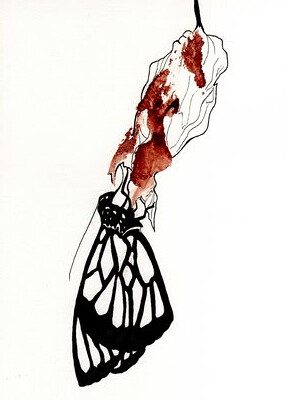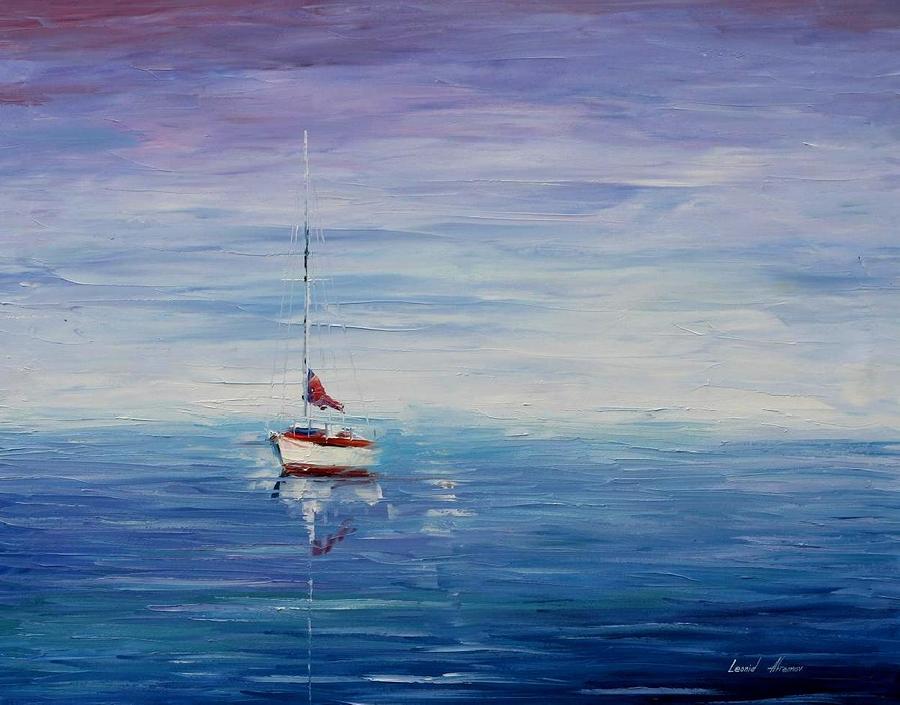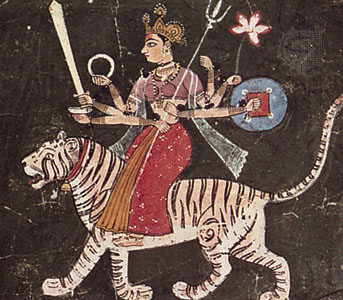Author: elahehia
Menstrala
Menstrala: menstrual art. Creating art from period blood. Yes, this is weird and strange and out of the norm but I also find it fascinating and I imagine to be liberating. I can just imagine your grotesque faces, twisted with horror but admit it: you feel fascination as well. And you can see how it can be liberating. Something so shrouded with stigma (God forbid we talk about periods in public or girls walk to bathrooms without veiling their tampons/pads with a folder and their shame) just being brought into light. Just like that. Revolted by period blood? Oh, here it is, in a painting. Beat that with a stick, motherfucker.
Anyways, where was I? Here’s a work by Vanessa Tiegs, who has extensive menstrala work.

However revolted you are by the fact that the red strokes you see were made by a female body’s excrement, you have to admit that there’s nothing but talent here. Using such an intimate source of pigment is almost like exposing your soul… Isn’t it? Or is that just me at 5 AM when sleep is kicking in?
I find this incredibly beautiful, think what you want of me.
Here’s South African artist Zanele Muholi’s work, a commentary on rape being used as a “cure” for lesbianism in some regions of Africa.

What she has to say about it: To read more about, click here.
Isilumo siyaluma is a Zulu expression that can be loosely translated as “period pains/ periods pain”. Additionally, there is an added meaning in the translation that there is something secretive in and about this blood/“period in time.â€
At one level, my project deals with my own menstrual blood, with that secretive, feminine time of the month that has been reduced within Western patriarchal culture as dirty.
On a deeper level then, my menstrual blood is used as a vehicle and medium to begin to express and bridge the pain and loss I feel as I hear and become witness to the pain of ‘curative rapes’ that many of the girls and women in my black lesbian community bleed from their vaginas and their minds.
To read more about, click here.
Another artist who combats the stigma of periods being dirty and unclean is May Ling Su. One of her videos is of her going to the beach naked and smearing herself with her period blood, breaking the whole can’t-go-to-the-beach-while-on-your-period “rule.” Here’s an image:
 There are entire communities and forums dedicated to menstrala. Here’s a fragile and delicate piece from Blood Art-Menstrala Live Journal community:
There are entire communities and forums dedicated to menstrala. Here’s a fragile and delicate piece from Blood Art-Menstrala Live Journal community:
 Well.
Well.
That’s it.
See you all next week, same time, same place.
Leonid Afremov: A New Kind of Artist
Okay.
Really quickly – what do you feel when you first see the following painting?

Joy. Bliss. Vibrancy. Color. Beauty. Happiness. (Yes, ‘color’ and ‘beauty’ are feelings.)
A smile.
That oil painting, my lads and lassies, was created by Leonid Afremov, whose rise to fame struck me as interesting. A few weeks ago, I spoke of Sergio Albiac whose domain is digital art, where he fuses painting with computer programs that results in futuristic and hauntingly amazing pieces of work. Afremov isn’t a new kind of artist the way Albiac is; his medium is as traditional as they get: oil paintings. However, his recognition and success is due to the harbinger of change in our technology-oriented society. The Internet.
That’s right. Before eBay, Afremov was the very picture (ha ha get it? He’s an artist.) of the stereotypical struggling artist. However, with eBay and other online means of vending, Afremov shot to fame and monetary success. And, if I may say so myself, justly so. He’s spectacular and his works fill me with a special fondness for the classic, romanticized Europe. Yes, the resplendent, almost magical, places he depicts do not exist in the gritty reality we live in but they do somewhere in our soul, our dreams. And when I gaze upon his work, I become uplifted with nostalgia, though I have never gone anywhere even remotely resembling such a place. Or maybe I have.

When I first saw one of his paintings, I thought it was some radical French painter from the centuries ago, maybe because . Nope. This man has a deviantART account. That’s right, muthafuckas. The man whose paintings seem to have popped out of old-world Europe has his paintings available for sale on deviantART (at the time of writing this, all the paintings on his deviantART account are for sale, so… go get ’em!). I admire The Internet to the fullest extent. Amazing things and people and art like this have always existed but The Internet spreads awareness that they exist, at a faster pace and to a bigger audience than ever before. A man who may have died with no one knowing his name is now an inspiration.

As a ballet dancer, the painting above tugs at my heartstrings.
Here’s what Afremov says on his deviantART profile:
Every artwork is the result of long painting process; every canvas is born during the creative search; every painting is full of my inner world. Each of my paintings brings different moods, colors and emotions. I love to express the beauty, harmony and spirit of this world in my paintings. My heart is completely open to art. Thus, I enjoy creating inspired and beautiful paintings from the bottom of my soul. Each of my artworks reflects my feelings, sensitivity, passion, and the music from my soul. True art is alive and inspired by humanity. I believe that art helps us to be free from aggression and depression.
Preach.


The Goddess
I’ve always found it interesting and amazing that the portraits of the (debatably most) important Hindu goddess, Durga, differed region to region. Before you roll your eyes, frown from incomprehension, or click at some other link, let me explain myself.
India is a wee bit complicated. The country itself doesn’t have one unified identity; there are many regions that have their own languages, ways of dressing, cuisines, ideologies, and traditions. To bring that into perspective, imagine going to Indiana, right downstairs, and everyone speaks a radically different language, the art and architecture look completely different from Michigan’s, the men and women wear togas rather than jeans, and you can’t recognize anything that they’re eating.
Yep.
So, in a sense, the word “Indian” doesn’t really mean anything in terms of summarizing a culture because… well, an “Indian” culture doesn’t exist.
Which makes the art throughout the country so interesting. Like so many other cultures around the world, art and religion are inextricably linked. Hinduism especially relies on art because it places such high importance in the visual aspect of religion. Stories of famous mythologies are painted on the streets and temples and images of gods and goddesses are omnipresent. I mean everywhere. Bumper stickers, posters on restaurant doors, statues at business entrances and every empty crook and cranny on the streets, walls in houses. Literally everywhere.
My dad’s job had us traveling throughout India so I couldn’t help but notice how radically different the images around me were, despite depicting the same figures. Durga is particularly interesting. She’s an Indian goddess in some sense because many Muslims and tribal people also worship some form of her, not just Hindus. She is hailed as the Supreme Goddess and the origin of all energy and life in the universe, a timeless maternal spirit that pervades everything, transcends time and religion, and ensures that the world remains in balance. Think Eywa, from the movie ‘Avatar.’
Here’s a statue of Durga from my home province, Andhra Pradesh.

Note how colorful and vivid it is. Also, note what the Goddess is wearing. A fairly simple sari. The people of Andhra are traditionally farmers, very rural people. Though we’re known for having a beautiful and poetic language, we’re simple people who toiled away in the lush lands of southern India. Hence, the folksy, bright colors and fairly simply draped sari. Juxtapose this with the sophisticated refinery that is the North.

Northern India has seen far more attacks and conquests, from the Muslim Mughals to the Christian British, and has been more directly placed under their rule than southern India. Thus, the depictions of the Goddess tend to be more anglicized and highly influenced by what is considered beautiful by that region of the country. Her body is generally made of white marble to reflect the more appealing (to them) aesthetic of having lighter skin. Her garlands are made of roses, as opposed to native flowers such as the hibiscus or the marigold flowers. Her jewelry is also more intricate and contains many gemstones and pearls whereas in southern depictions, She wears extremely ornately designed gold due to relative abundance of gold and lack of gemstones in the south.

Depictions of Durga from the state of Bengal are radically different from all other regions, especially in terms of Her distinct facial structure. Also, while northern India generally depicts Durga as marble white and southern India depicts Her with a more flesh-colored tone, Bengalis depict Her with yellow skin. I mean the yellowest yellow of all the yellows you’ve ever seen. Her bindi (the marking on her forehead) is also more intricate than the standard red dot and her jewelry is out of this world.

Durga is the Bengal’s most loved deity and Her festivals are celebrated with more pomp than any other.
A depiction of Durga from Tamil Nadu, the southernmost state of India:

Her skin color is a lot darker. It is also common to find Durga statues made of black marble in these parts of India because they more accurately depict the darker pigmentation of southern Indians. Also, Her bindi is completely different (three horizontal lines and a red dot in the middle) to reflect a more popular strand of Hinduism in Tamil Nadu. The usage of animals more prevalent in this region, such as buffalo, is common in imagery associated with Her.
The following depiction is from Rajasthan, a state in the north that perhaps had the greatest association with the Muslim Mughals. She has on a blouse and a long skirt and drapes Her sari over her shoulders rather than tying it around her body, like the women of Rajasthan. The way She’s painted, with Her head facing the side but Her body facing the viewer, is a direct influence of the Mughals, who also painted their figures this way.

In the coastal Orissa, where peacocks are especially used as a sign of beauty and majesty, silver is abundant, and jewelry is designed after the beautiful conches and seashells found along the beaches.

In Assam and Tripura:

Depictions of the Goddess are endless. There are paintings and statues of Her naked, clothed, blue, green, black, orange, with bindis of all shapes and sizes, with Oriental features, with blue eyes, etc, etc, etc. But this post is getting way too long and I’ve realized now that none of these pictures do justice to Her or to the beautiful statues and paintings they’re portraying.
Cosplay
If you’re not familiar with the term, it’s when people dress up as characters, especially characters from video games. This may seem harmless. Until this happens.
 Yeah.
Yeah.
Let’s face it. Video games are sexist. This may be because they cater to a group of adolescent boys who have not yet ventured completely into the world of the opposite sex and have based their knowledge of romance and women on what they learn from the media. And cosplay, at least in this form, only reinforces the sexism.
I have read many defenses of cosplay. It’s for fun. It means nothing. It’s an art form. Well, yes. Everything, in a way, is art, right? That, in no way, excuses and justifies blatant misogyny.
And don’t give me bullshit about these women are simply embracing themselves and their bodies and their sexy sides or some moronic excuse like that. If the woman in the above picture was obese, would she have received the overwhelming popularity that she has? Would she be celebrated as a woman simply celebrating her body? Women who feel the need to dress like this are adopting the sexist construct of beauty in order to feel valued.
The woman in that picture is Jessica Nigri, in case you were wondering/you wanted to Google more pics of her. She makes her own costumes and does this on her own time. But that doesn’t meant that the art form she is participating in deserves merit. Art has connotations of purity and an almost untouchable nobility but I beg to differ. This is art but at the same time, it’s disgusting.
And NO, I’m not slut-shaming. I’m not commenting on what she’s wearing and telling her not to wear it. I’m just begging people not to adhere to a fucked up notion of beauty.
-End rant-

